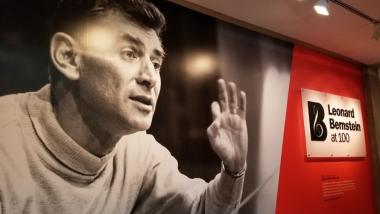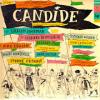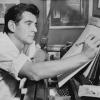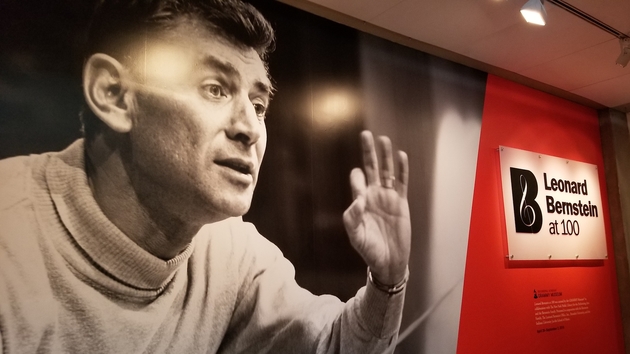
Orchestras around the world have been celebrating the 100th birthday of Leonard Bernstein. But it fell to Robert Santelli, founding director of the Grammy Museum and a self-admitted newcomer to the realm of classical music, to curate the centennial museum exhibition that celebrates Bernstein’s life and musical legacy.
Four years in the making, Bernstein at 100 is now on display at the Skirball Cultural Center in Los Angeles, following its premiere at the Kennedy Center in Washington D.C. and presentation at Lincoln Center and the New York Public Library. Featuring a fascinating array of personal artifacts, including letters, scores, multimedia displays, memorabilia, interviews, film clips, and key recordings, the exhibit will be on display through Sept. 2 — including the actual date of Bernstein’s 100th birthday on Aug. 25.
“We are not necessarily a museum about music,” said Robert Kirschner, director of the Skirball Cultural Center, “but we have found that music exhibitions — whether it’s been about Paul Simon, Bob Dylan, or Bill Graham— is [sic] part of our mission. Music is about people coming together as a community. We are also about what we perceive to be Jewish values. And the fact that Leonard Bernstein was Jewish made this, out first exhibition devoted to classical music, a perfect fit.”
In fact, this collaboration between the Grammy Museum and the Skirball represents a first foray into classical music for both organizations.
During two preparatory years of research, Santelli discovered a wealth of materials, from key sources like the Library of Congress, the New York Philharmonic Archive, and the New York Library of the Performing Arts. He also received a great deal of assistance, he said, from the Bernstein family, including Leonard Bernstein’s son, Alexander.
But of all the objects, the one Santelli is most proud of, the artifact that took the most negotiation to obtain, is Aunt Clara’s piano, on loan (however begrudgingly) from Brandeis University. It is the instrument on which Bernstein’s musical path really began.
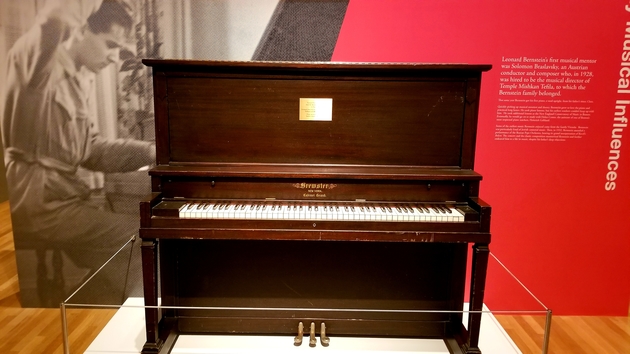
“As my father told it,” Alexander Bernstein explained during a walk through the exhibit, “Aunt Clara moved out of her house and didn’t have room for the piano. So she dumped it on our family. I know it sounds like a Hollywood movie, but my father said when he touched one key, he knew. By the end of a week he was teaching himself basic harmony. Shortly after that he started taking lessons.”
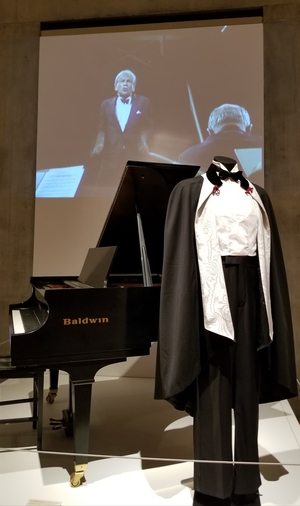
Another object of great significance to the Bernstein family history is an odd-looking contraption that one young student identified as an electric chair! Its actual purpose was a good deal more benign and fashion-oriented.
“My grandfather held the exclusive New England license for a piece of beauty parlor equipment that was popular in the 1920 and 30s — the electric permanent wave machine,” Alexander Bernstein explained. “He formed the Samuel J. Bernstein Hair Company and did very well. So my father grew up in an upper-middle class Jewish family.”
“We found it on eBay,” said Santelli proudly. “Now it’s part of the permanent collection of the Grammy Museum.”
With the exception of obtaining Aunt Clara’s piano, curating the exhibit, Santelli said, was more a question of editing than struggling to find material. “There are a half a million pieces related to Bernstein at the Library of Congress!”
The result is a chronological guided tour through Bernstein’s life that attempts to portray the various aspects of his persona: the composer, the conductor, the educator, the television personality and the father. The exhibit also makes mention of Bernstein’s sexual orientation in a display devoted to his family life.
“Leonard Bernstein was bi-sexual and had many relationships with men throughout the years. By all accounts Felicia [Montealegre, his wife and the mother of his three children: Alexander, Nina and Jamie] understood his homosexuality was an irrefutable part of him… Eventually though the double life fractured their marriage.”
The challenge or curating the exhibition, Santelli felt, was to tell the story to adults that already have an intimate knowledge of Bernstein that would also prove interesting and illuminating as an educational tool for students who have probably never heard of Leonard Bernstein.”
In terms of its objects and storytelling, Bernstein at 100 is a wonderful biographical portrait. One gallery features the standing desk from the family’s country house in Fairfield, Connecticut where Bernstein composed the Kaddish symphony, Chichester Psalms, and his Mass. In another gallery, there’s the decidedly functional desk and chair where he produced West Side Story.
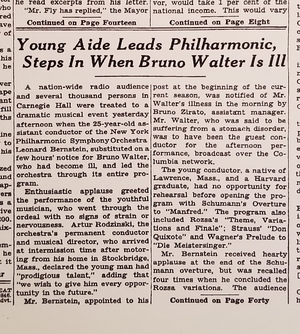
There is a display case devoted to Bernstein’s premiere with the New York Philharmonic on Nov. 14, 1943, when Bernstein — the orchestra’s 25-year-old assistant conductor — filled in for an ailing Bruno Walter. As reported in The New York Times, “Enthusiastic applause greeted the performance of the youthful musician, who went through the ordeal with no signs of strain or nervousness.”
You can see Bernstein’s traveling trunks, his dapper tuxedo, one of his last Baldwin pianos, sheet music, posters, a section devoted to On the Waterfront, and there are batons, including one from a very momentous performance — not conducted by Bernstein!
On Nov. 29, 2007, Gustavo Dudamel was about to make his debut performance with the New York Philharmonic. As a gesture of welcome to the young Venezuelan, the orchestra’s archivist, Barbara Haws, asked Dudamel if he would like to use one of Bernstein’s batons. Dudamel was honored, having seen Bernstein as a key figure in his musical life.
Everything went brilliantly, according to Dudamel, who recounts the story in a recorded interview. Then, 15 seconds before the climax of the Prokofiev’s Fifth Symphony, the baton shattered. Dudamel, who had recently conducted the same piece with his student orchestra, had no problem getting through those last 12 seconds. But he has always been convinced that he somehow channeled the spirit of Leonard Bernstein. And there in the exhibit, in its Lucite case, lies the baton, broken in two.
Ironically, there is another baton in the exhibit from the 1950s. It’s the first object you encounter and it’s accompanied by this quote from Bernstein: “The baton must be a living thing charged with a kind of electricity.” It’s a connection worthy of Harry Potter — could it be that the baton choses the maestro?
Centenaries are always excellent inspirations for exhibitions. In that tradition, Bernstein at 100 is a worthy tribute.
Exhibition Information:
Skirball Cultural Center - 2701 N. Sepulveda Blvd, Los Angeles
Hours: Tuesday-Friday, noon-5 p.m.; Saturday and Sunday, 10 a.m.-5 p.m.; through Sept. 2.
Admission: $12, $9 seniors and students and children over 12, $7 children 2-12. Free admission all-day Thursday.
Information: skirball.org or (310) 440-4500.

